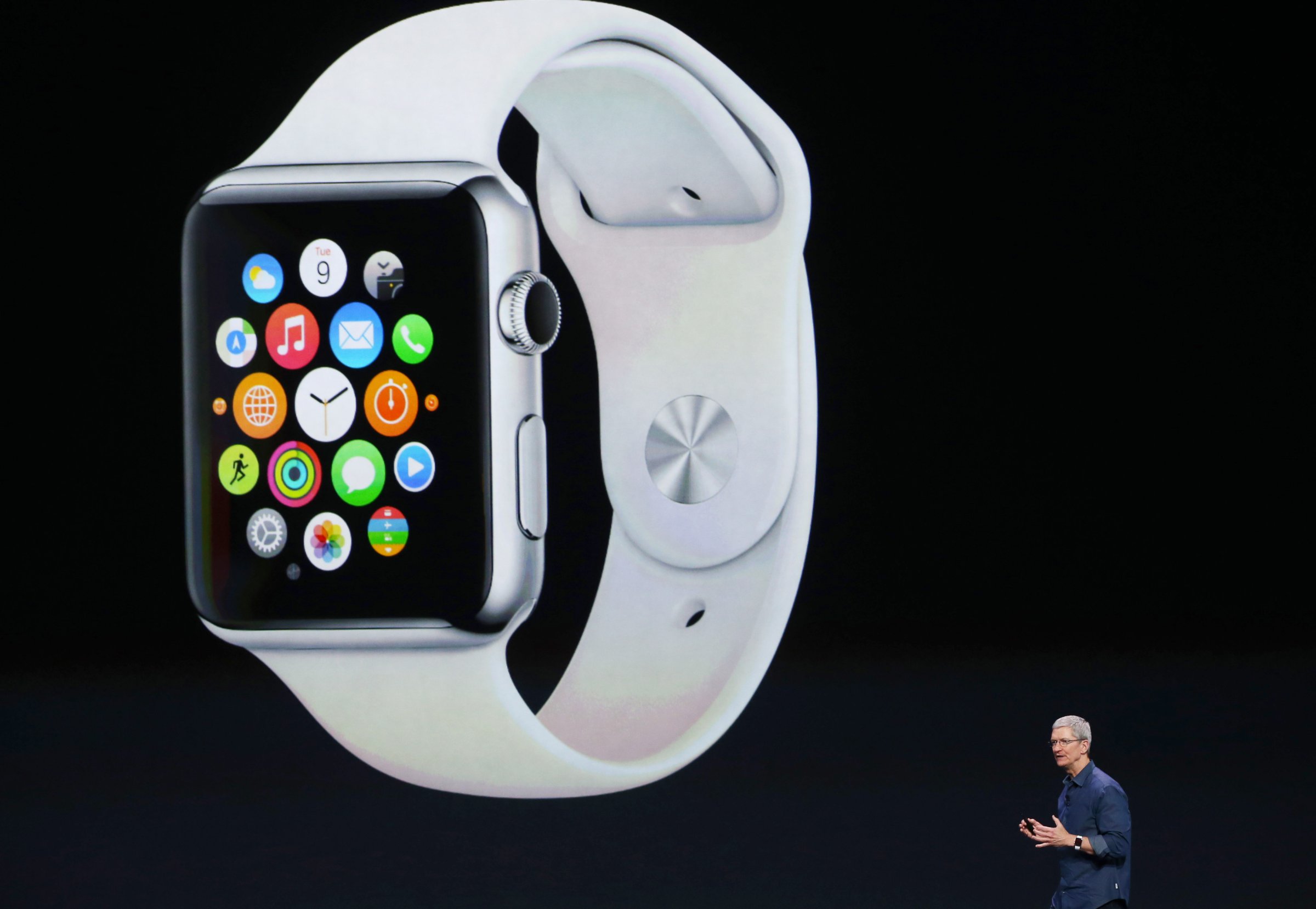
Many of us already feel as if we’re handcuffed to our computers. With its new smart watch, unveiled today in California, Apple is hoping to turn that figure of speech into a literal truth.
Apple has a lot riding on the diminutive gadget. It’s the first major piece of hardware the company has rolled out since the iPad made its debut four years ago. It’s the first new product to be designed under the purview of fledgling CEO Tim Cook. And, when it goes on sale early next year, it will be Apple’s first entry in a much-hyped product category—wearable computers—that has so far fallen short of expectations. Jocks and geeks seem eager to strap computers onto their bodies. The rest of us have yet to be convinced.
Apple has some experience in taking a lackluster new product and turning it into a must-have for the masses. When it released its iPod in 2001, there were already plenty of MP3 players on the market. None of them, though, had garnered much interest. The iPod, with its simple interface and copious capacity, broke the market open—and revolutionized the music business in the process. With the elegantly designed, eye-catching Apple Watch, the company is hoping to pull off a similar feat for wearables.
But there’s a bigger story here. If the Apple Watch proves popular, it will not just mark “the next chapter in Apple’s story,” as Cook described it. It will change our relationship to computers, weaving the already ubiquitous devices and their apps even more deeply into the fabric of our lives. The personal and social ramifications could be far-reaching.
For a precedent, we need only look back to the development of the last great arm-mounted technology: the wristwatch. The early history of time-keeping machines bears a striking resemblance to the recent evolution of digital computers. Both are stories, at a technical level, of miniaturization and personalization, and both reveal how changes in the design of a common technology can alter not only its function but also the way it influences personal behavior and social norms.
Mechanical clocks started out as large, institutional machines. Installed in cathedrals and town halls, they were the mainframes of their time, and they had a profound effect on the way people lived. Time, which had previously been experienced as a natural, cyclical flow, began to be experienced as a succession of discrete, precisely measurable units. Hours, minutes, and seconds ticked away with industrial exactitude, and people quickly adapted themselves to the new, martial rhythm. Society became more productive and predictable as well as more regimented.
That was just the start. As inventors discovered ways to build smaller, less expensive clocks, the devices moved into people’s homes in the form of wall clocks and floor clocks — the equivalent of the bulky desktop PC that in the 1980s became a fixture of the modern home. With further engineering breakthroughs, clock mechanisms continued to shrink, leading to the creation of the pocket watch. People started carrying time-keeping machines around with them all day, just as we do with our smartphones.
Then, finally, came the wristwatch. People no longer had to pull their time-keeping machines out of their pockets to consult them. The technology was now always in view, becoming, in effect, an extension of the human body. Affixed to the wrist, the watch, as the late historian David Landes explained in his book Revolution in Time, became “an ever-visible, ever-audible companion and monitor.” By continually reminding its wearer of “time used, time spent, time wasted, time lost,” it served as both “prod and key to personal achievement and productivity.” The wristwatch, Landes argued, played a major role in spreading the ethic of individualism throughout Western culture.
At $349, the Apple Watch is pricey, and the device’s success remains uncertain. It does seem likely, though, that the gadget’s arrival will open yet another chapter in the story of personal computing. The watch, as today’s demos revealed, is the most solicitous computer yet. It taps you on the wrist whenever a new message or alert comes in. It formulates answers to questions you receive from friends. It reminds you where you parked your car. It tracks your health. It even allows you to broadcast your heartbeat to others.
That’s all very exciting, but some wariness is in order. As the history of clocks reveals, strapping a technological companion and monitor onto your wrist can alter, in ways that are hard to foresee, life’s textures and rhythms. And never before have we had a tool that promises to be so intimate a companion and so diligent a monitor as the Apple Watch.
Nicholas Carr is the author of the forthcoming book The Glass Cage: Automation and Us.
More Must-Reads from TIME
- Cybersecurity Experts Are Sounding the Alarm on DOGE
- Meet the 2025 Women of the Year
- The Harsh Truth About Disability Inclusion
- Why Do More Young Adults Have Cancer?
- Colman Domingo Leads With Radical Love
- How to Get Better at Doing Things Alone
- Michelle Zauner Stares Down the Darkness
Contact us at letters@time.com